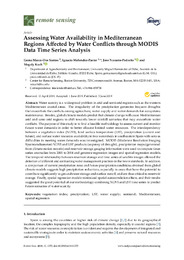Título :
Assessing Water Availability in Mediterranean Regions Affected by Water Conflicts through MODIS Data Time Series Analysis |
Autor :
Melendez-Pastor, Ignacio 
Navarro-Pedreño, Jose 
Marco Dos Santos, Gema
Koch, Magaly  |
Editor :
MDPI |
Departamento:
Departamentos de la UMH::Agroquímica y Medio Ambiente |
Fecha de publicación:
2019 |
URI :
https://hdl.handle.net/11000/34557 |
Resumen :
Water scarcity is a widespread problem in arid and semi-arid regions such as the western
Mediterranean coastal areas. The irregularity of the precipitation generates frequent droughts
that exacerbate the conflicts among agriculture, water supply and water demands for ecosystems
maintenance. Besides, global climate models predict that climate change will cause Mediterranean
arid and semi-arid regions to shift towards lower rainfall scenarios that may exacerbate water
conflicts. The purpose of this study is to find a feasible methodology to assess current and monitor
future water demands in order to better allocate limited water resources. The interdependency
between a vegetation index (NDVI), land surface temperature (LST), precipitation (current and
future), and surface water resources availability in two watersheds in southeastern Spain with serious
di culties in meeting water demands was investigated. MODIS (Moderate Resolution Imaging
Spectroradiometer) NDVI and LST products (as proxy of drought), precipitation maps (generated
from climate station records) and reservoir storage gauging information were used to compute times
series anomalies from 2001 to 2014 and generate regression images and spatial regression models.
The temporal relationship between reservoir storage and time series of satellite images allowed the
detection of di erent and contrasting water management practices in the two watersheds. In addition,
a comparison of current precipitation rates and future precipitation conditions obtained from global
climate models suggests high precipitation reductions, especially in areas that have the potential to
contribute significantly to groundwater storage and surface runo , and are thus critical to reservoir
storage. Finally, spatial regression models minimized spatial autocorrelation e ects, and their results
suggested the great potential of our methodology combining NDVI and LST time series to predict
future scenarios of water scarcity.
|
Palabras clave/Materias:
vegetation index
precipitation
LST
water supply
semiarid
Mediterranean
spatial regression |
Área de conocimiento :
CDU: Ciencias aplicadas: Agricultura. Silvicultura. Zootecnia. Caza. Pesca: Agricultura. Agronomía. Maquinaria agrícola. Suelos. Edafología agrícola |
Tipo de documento :
info:eu-repo/semantics/article |
Derechos de acceso:
info:eu-repo/semantics/openAccess
Attribution-NonCommercial-NoDerivatives 4.0 Internacional |
DOI :
https://doi.org/10.3390/rs11111355 |
Publicado en:
Remote Sensing |
Aparece en las colecciones:
Artículos Agroquímica y Medio Ambiente
|

 La licencia se describe como: Atribución-NonComercial-NoDerivada 4.0 Internacional.
La licencia se describe como: Atribución-NonComercial-NoDerivada 4.0 Internacional.
.png)